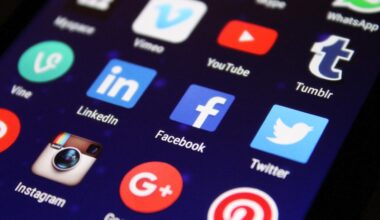Case Study: Starbucks’ Mobile App Social Features Driving Brand Awareness and Loyalty
Starbucks has effectively utilized its mobile application to enhance brand awareness and foster customer loyalty. The app integrates various social media features, allowing users to share their experiences and favorite beverages. This user-centric approach not only improves customer engagement but also expands their reach across platforms like Instagram and Facebook. By encouraging customers to post their Starbucks moments using specific hashtags, the brand cultivates a community of passionate fans. This engagement leads to increased foot traffic in stores, as users are motivated to visit frequently to enjoy their favorite drinks while sharing the experience. Additionally, Starbucks leverages data analytics to track user behavior, subsequently tailoring their marketing strategies based on insights gathered from app interactions. Thus, their mobile application not only promotes brand awareness but also reinforces customer loyalty through personalized marketing efforts. The combination of social features, rewards, and seamless payment options results in an all-in-one experience that resonates with the customers, ultimately driving profitability and growth for the brand. As Starbucks continues innovating its app features, the brand remains a leading example in effectively using social media tools to enhance customer relationships.
Starbucks’ mobile app is designed with features that keep customers engaged and involved. One notable aspect is the rewards program integrated within the app, which incentivizes users to participate more actively. Customers earn points from every purchase made through the app and can redeem these points for exclusive drinks or food items. In addition, users can customize their orders and pay directly from the app, making the purchasing experience seamless. This convenience encourages repeat usage and ensures that Starbucks remains the preferred choice for many coffee lovers. The app’s social sharing functionality elevates this experience as customers are invited to share their rewards or special drinks on social media platforms. This not only showcases the brand but also instills a sense of exclusivity among users, as they feel part of an elite group. Furthermore, the app allows users to explore various promotional offers, ensuring that they remain engaged and informed about new product launches. The introduction of seasonal drinks like the Pumpkin Spice Latte becomes even more impactful as sharing creates buzz, thus driving sales during peak seasons. Starbucks effectively marries convenience with social engagement to foster brand loyalty.
The Power of User-Generated Content
A significant influencer in Starbucks’ brand awareness efforts is user-generated content, effectively harnessed through the mobile app. By creating a platform for customers to share their experiences, Starbucks encourages organic promotion. For instance, when customers post their favorite drink or a unique Starbucks experience on platforms like Instagram, they amplify the reach of the brand beyond traditional marketing. Each post serves as a personal endorsement, suggesting to followers that visiting Starbucks is a must-do. Additionally, contests and campaigns that focus on user-generated content incentivize customers to engage creatively with the brand. For example, a photo-sharing contest featuring customer-favorite customized beverages can go viral, significantly boosting brand visibility. Customers feel a sense of pride when their content is featured by Starbucks, further enhancing emotional connection and brand affinity. This unique approach allows Starbucks to tap into the authenticity of its customer base, lending credibility to its marketing efforts. Moreover, user-generated content fosters a sense of community, demonstrating the brand’s understanding of its diverse audience while encouraging ongoing participation, effectively turning customers into ambassadors who voluntarily promote Starbucks across various media.
Moreover, Starbucks’ successful leveraging of social media within their mobile app extends beyond user-generated content. The app’s notification system keeps customers informed about exclusive deals, upcoming events, and seasonal releases, ensuring they never miss out on something new. This proactive communication strategy ensures that customers always feel connected, enhancing anticipation for relevant launches. The brand employs a strategy of limited-time offers, encouraging customers to share these promotions across social channels. This creates a fear of missing out (FOMO), motivating users to visit stores to take advantage of time-sensitive offers. Additionally, the integration of location-based services within the app allows Starbucks to send personalized promotions to users based on their geographic locations. These efforts cater to the individual preferences of customers, driving foot traffic to specific locations. This precedence on personalization not only strengthens customer retention but also influences potential customers who may have been exposed to enticing promotions. By catering to customer preferences and upholding high engagement levels, Starbucks reinforces its reputation as a formidable brand in a highly competitive landscape, putting its mobile app at the center of effective marketing strategies.
Community Engagement Through Social Functions
Starbucks places considerable emphasis on community engagement via its app, making it an essential tool for building brand loyalty. The app features a social feed where customers can view drink ideas or recipes from other users and receive recommendations based on popular choices. This not just provides inspiration but creates a collaborative environment where customers feel part of the Starbucks community. Engaging actively in such virtual spaces promotes the exchange of ideas, fostering creativity and wider product exposure. Starbucks also organizes local community events advertised through the app, encouraging users to connect offline by participating in coffee tasting sessions or art shows. These events enhance customer interaction with the brand in meaningful ways and deepen their emotional connection. Reinforcing the idea that Starbucks goes beyond being a mere coffee shop, such initiatives build warmth, community, and loyalty. Users developed lasting memories attached to the Starbucks experience that translates into repeat visits. By championing meaningful connections through community-driven events and social sharing features, Starbucks effectively cultivates an ecosystem that emphasizes customer loyalty as a core brand value, solidifying their esteem.
Starbucks has also streamlined its marketing efforts through feedback collected via its app. Users can rate services, provide instantaneous feedback, and even suggest new products directly through the application. This insight is invaluable and helps Starbucks understand evolving customer preferences and address any challenges on the spot. Regular analysis of this data informs promotional strategies and product developments, leading to the creation of popular limited-time offerings or seasonal specials that delight customers. Such responsiveness not only makes customers feel valued but strengthens their allegiance to the brand because users see Starbucks actively taking their opinions into account. This feedback mechanism also allows Starbucks to identify trends and swiftly adapt to changing consumer behavior. As trends emerge, the brand can leverage its app’s reach to introduce new marketing campaigns that align with customer interests. This agile approach encourages ongoing engagement, sustaining discussions around products as customers feel an emotional investment. Ultimately, the way that Starbucks incorporates user feedback is another key driving force in their brand loyalty and is instrumental in championing their leading role in the competitive coffee industry.
The Future of Starbucks’ Mobile Engagement
Looking ahead, Starbucks is poised to continue evolving its mobile engagement strategy. As technology advances, the potential for richer experiences on their app is vast. Future features may include augmented reality experiences, allowing customers to interact with their favorite drinks in a virtual environment. Such innovations align with modern consumers’ expectations for interactive experiences and can engage users at unprecedented levels. Moreover, deepening analytics could refine Starbucks’ understanding of user behavior further and allow for hyper-personalization. Features that offer real-time rewards or social challenges among friends could foster even healthier competition among consumers, enhancing social sharing aspects. Furthermore, expanding partnerships with other brands for crossover promotions via the app could introduce unique campaigns. For instance, collaborations with popular entertainment franchises or food brands that resonate with young audiences could be highly beneficial. Ultimately, as Starbucks leverages technology alongside its community-driven approach, the possibilities are expansive. This dedication to evolving customer experience through the mobile app will ensure that Starbucks remains a pioneer in leveraging social media to enhance brand awareness and loyalty, setting trends that others in the industry will likely follow.
In conclusion, Starbucks exemplifies the power of effective mobile app strategies driven by social media to enhance brand awareness and nurture loyalty among its customers. By integrating user-generated content, rewards programs, community engagements, and personalized marketing techniques, the brand has elevated its position in a competitive market. The innovative use of social features within the app has not only captivated existing customers but attracted new demographics as well. As Starbucks continues to explore new technological advancements and trends, its commitment to customer engagement will propel it to even greater heights. By providing unparalleled experiences and emphasizing community-building efforts, Starbucks is on a steadfast mission to enhance brand visibility and maintain its rightful place as a leader in the coffee sector. Clients will likely remain enthusiastic as they engage with the brand, creating valuable relationships that last. Overall, Starbucks’ case study illustrates a blueprint that brands can replicate to effectively harness the power of social media and mobile technology for increasing brand loyalty and awareness, ultimately leading to sustainable growth and customer satisfaction across the board.


